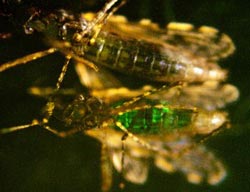Genetically Engineered Bacteria Prevent Mosquitoes From Transmitting Malaria

Johns Hopkins Malaria Research Institute <br>Genetically engineered bacteria glow fluorescent green inside mosquito.<br><br>
The bacterium, Pantoea agglomerans, was modified to secrete proteins toxic to the malaria parasite, but the toxins do not harm the mosquito or humans. According to a study published by PNAS, the modified bacteria were 98 percent effective in reducing the malaria parasite burden in mosquitoes.
“In the past, we worked to genetically modify the mosquito to resist malaria, but genetic modification of bacteria is a simpler approach,” said Marcelo Jacobs-Lorena, PhD, senior author of the study and a professor with Johns Hopkins Bloomberg School of Public Health. “The ultimate goal is to completely prevent the mosquito from spreading the malaria parasite to people.”
With the study, Jacobs-Lorena and his colleagues found that the engineered P. agglomerans strains inhibited development of the deadliest human malaria parasite Plasmodium falciparum and rodent malaria parasite Plasmodium berghei by up to 98 percent within the mosquito. The proportion of mosquitoes carrying parasites (prevalence) decreased by up to 84 percent.
“We demonstrate the use of an engineered symbiotic bacterium to interfere with the development of P. falciparum in the mosquito. These findings provide the foundation for the use of genetically modified symbiotic bacteria as a powerful tool to combat malaria,” said Jacobs-Lorena.
Malaria kills more than 800,000 people worldwide each year. Many are children.
The authors of “Fighting malaria with engineered symbiotic bacteria from vector mosquitoes” are Sibao Wang, Anil K. Ghosh, Nicholas Bongio, Kevin A. Stebbings, David J. Lampe and Marcelo Jacobs-Lorena.
The research was supported by National Institute of Allergy and Infectious Diseases, the Bill & Melinda Gates Foundation, the Johns Hopkins Malaria Research Institute and the Bloomberg Family Foundation.
Follow the Johns Hopkins Bloomberg School of Public Health on Facebook at http://www.facebook.com/JohnsHopkinsSPH and Twitter at http://www.twitter.com/JohnsHopkinsSPH.
Tim Parsons
410-955-7619
tmparson@jhsph.edu
Media Contact
More Information:
http://www.jhsph.eduAll latest news from the category: Life Sciences and Chemistry
Articles and reports from the Life Sciences and chemistry area deal with applied and basic research into modern biology, chemistry and human medicine.
Valuable information can be found on a range of life sciences fields including bacteriology, biochemistry, bionics, bioinformatics, biophysics, biotechnology, genetics, geobotany, human biology, marine biology, microbiology, molecular biology, cellular biology, zoology, bioinorganic chemistry, microchemistry and environmental chemistry.
Newest articles

High-energy-density aqueous battery based on halogen multi-electron transfer
Traditional non-aqueous lithium-ion batteries have a high energy density, but their safety is compromised due to the flammable organic electrolytes they utilize. Aqueous batteries use water as the solvent for…

First-ever combined heart pump and pig kidney transplant
…gives new hope to patient with terminal illness. Surgeons at NYU Langone Health performed the first-ever combined mechanical heart pump and gene-edited pig kidney transplant surgery in a 54-year-old woman…

Biophysics: Testing how well biomarkers work
LMU researchers have developed a method to determine how reliably target proteins can be labeled using super-resolution fluorescence microscopy. Modern microscopy techniques make it possible to examine the inner workings…





















